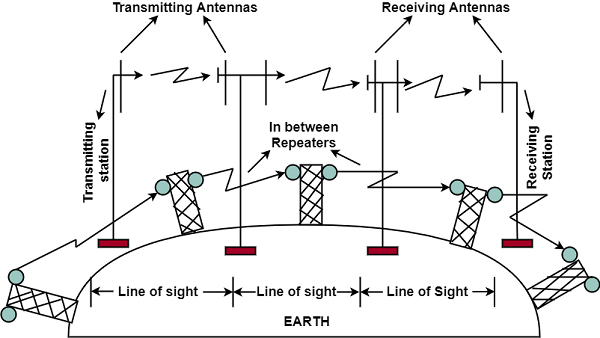
 Data Structure
Data Structure Networking
Networking RDBMS
RDBMS Operating System
Operating System Java
Java MS Excel
MS Excel iOS
iOS HTML
HTML CSS
CSS Android
Android Python
Python C Programming
C Programming C++
C++ C#
C# MongoDB
MongoDB MySQL
MySQL Javascript
Javascript PHP
PHP
- Selected Reading
- UPSC IAS Exams Notes
- Developer's Best Practices
- Questions and Answers
- Effective Resume Writing
- HR Interview Questions
- Computer Glossary
- Who is Who
What is Microwaves Transmission?
The electromagnetic waves having frequencies between 1 and 300 GHz are known as a microwave. Microwave systems use very high-frequency radio or television signals to transmit data through space. Therefore, the transmitter and receiver of a microwaves system, which is mounted on very high towers, should be invisible to each other, i.e., they both should be in a line-of-sight. Moreover, the signals become weak after travelling a certain distance and require power amplification.

Microwave systems can carry large quantities of data at high rates of speed. The data transmission rate is about 16 gps (Gigabits per second). A microwave system can take 250,000 voice channels at the equivalent time. They are used for the transmission of Radio, TV, and telephone signals.
Characteristics of Microwaves Transmission
The main characteristics of microwaves transmission are as follows −
- Microwaves are unidirectional. When an antenna sends microwaves, it can narrowly focus it. This defines that the sending and receiving antennas require to be aligned.
- Microwaves propagation is line-of-sight.
- It is very high –frequency microwaves cannot penetrate walls.
- The microwave band is associatively wide, almost 299 GHz. Therefore, wider subbands can be authorized, and a high data rate is possible.
Advantages of Microwaves Transmission
Following are the advantages of microwaves transmission −
- High data transmission rates.
- High capacity to carry huge quantities of data.
- Lower error rates, thus making it more reliable as compared to cable.
- Microwaves offer communication over very long distances.
- They have a better implementation in bad weather conditions than radio waves.
Disadvantages of Microwaves Transmission
Following are the disadvantages of microwaves transmission −
- It is expensive.
- Electromagnetic waves cannot bend or move through obstacles like mountains etc.
- It requires repeaters for long-distance transmission.
- Microwave signals are vulnerable to electromagnetic interference (EML). Microwave systems are also affected by atmospheric conditions.
- This communication offers limited bandwidth.

